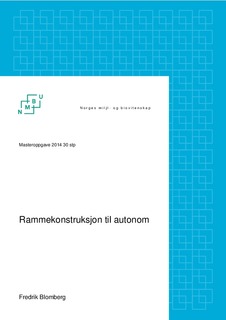| dc.contributor.author | Blomberg, Fredrik | |
| dc.date.accessioned | 2014-08-06T13:00:48Z | |
| dc.date.available | 2014-08-06T13:00:48Z | |
| dc.date.copyright | 2014 | |
| dc.date.issued | 2014-08-06 | |
| dc.identifier.uri | http://hdl.handle.net/11250/216808 | |
| dc.description | Oppgaven beskriver utviklingen og konstruksjonen av rammen til en autonom landbruksmaskin | nb_NO |
| dc.description.abstract | Formålet med oppgaven er å konstruere en ramme til en autonom landbruksmaskin. Landbruket i dag preges av store og tunge maskiner. Landbruksmaskinene vokser i størrelse for å gjøre landbruket mer effektivt. En stor maskin kan utføre mer arbeid på mindre tid. Men når maskiner blir tunge fører det til jordpakking. Når jordsmonnet blir sammentrykt blir kvaliteten på jorda reduseres. I dagens landbruk går 90% av drivstofforbruket til håndtering av jordpakking. Denne oppgaven er en del av et forskningsprosjekt som har til hensikt å utvikle autonome løsninger på jordpakking og implementering av presisjonslandbruk.
Prosjektgruppen har arbeidet med robotstyringer og fremdrift for kjøretøyer i ulendt terreng, og analysert utfordringene norsk landbruk står overfor. På denne bakgrunn utarbeidet gruppen spesifikke krav den autonome landbruksmaskinen må tilfredsstille. Kravene er at maskinen skal ha fremdrift på alle hjul, batterier som energikilde, sving på samtlige hjul for gode manøvreringsegenskaper og ha lav vekt. Konseptet gruppen utviklet, innebærer at roboten bærer verktøyet i stedet for å trekke det etter slik som traktorer gjør.
I oppgaven analyseres ideer og materialvalg til rammen. Det er brukt beregninger og simuleringer for å finne dimensjoner på komponenter i konstruksjonen. Vår landbruksmaskin består av en U-formet ramme med et åpent område i midten hvor verktøyet kan monteres. I hjørnene monteres en kombinert svinge- og fremdriftsmekanisme. Fremdriften blir drevet av likestrømsmotorer mens servomotorer svinger hjulene. For å få ønsket arbeidsmoment blir det montert gir med utvekslingsforhold 1:60 på hver motor. Mellom servomotoren og underarmen hvor hjulene er plassert er det to koniske rullelager. Rullelagrene er overdimensjonerte og kan byttes ut til mindre vinkelkontakt kulelager. Arbeidsområdet til roboten er på ujevne underlag. For optimal fremdrift må hjulene og være bevegelige slik at dekkene kan ha kontakt med underlaget. Rammen er gjort bevegelig ved å bruke aluminiumsrør som rammeelementer og hengsle verktøyet til rammen med momentfrie ledd. Resultatene fra simuleringer og utførte beregninger viser at det er tilstrekkelig med 60x30x2,5 millimeter tverrsnitt på aluminiumsrørene. For å gjøre systemet rimeligst mulig skal roboten være utstyrt med mesteparten av elektroniske utstyret som er nødvendig for de ulike applikasjoner.
The main objective of this thesis is to construct a frame for an autonomous agriculture machine. Today the agriculture sector consist of large and heavy machinery. Agriculture machines grow in size to become more effective. A large machine can do more work in less time then a smaller machine. But heavy machines causes the soil to compress. The quality of the soil reduces when the soil become compressed. About 90 % of the energi consumption is used to overcome probles related to compressed soil. This thesis is part of a scientific project which develops an autonomous solution to compressed soil and implementing presicion farming.
The project group have worked with controlling electrical motors, with aspects regarding driving a vehicle in terrain and analyzed challenges in the Norwegian agriculture and how to overcome this challenges. From this analysis we made requirements for the autonomous machine. The requrements were: Four wheel drive system, batteries as energy source, all of the wheels with steering cability and a low weight design. Insted of pulling the tools like tractors oparate the robot will carry the tools.
In this thesis design ideas and choice of construction materials are analyzed. Suitable dimensions on parts are found by using simulations and calcutaltions. With a U-shaped frame it’s possible for tools to mount in the center of the robot. In each corner a combined propulsion and stearing mechanism. The propulsion motor is a direct current motor and the stearing motor a presice servomotor. It was necessary to combine each motor with a gear to get desired output momentum. Between the servomotor and the arm holding the wheels there is two tapered roller bearings. The bearings are oversized and can be replaced by smaller angular contact ball bearings. The main working area for the robot will be on soil. To make sure every wheel always stays in contact with the ground the frame is constructed flexible. Aluminium tubes makes the frame deflectable. Tools mounted inside the frame are hinged with rotational links. Results from simulations and calculations concludes that it is sufficient with a aluminium tube cross section of 60x30x2,5 mm. By mounting most of the necessary electronics onboard the robot, instead on each tool, we can reduce the retail price of the system. | nb_NO |
| dc.description.sponsorship | NJF | nb_NO |
| dc.language.iso | nob | nb_NO |
| dc.publisher | Norwegian University of Life Sciences, Ås | |
| dc.subject | VDP::Teknologi: 500::Maskinfag: 570 | nb_NO |
| dc.title | Rammekonstruksjon for autonom landbruksmaskin | nb_NO |
| dc.title.alternative | Frame construction for autonomous agriculture machine | nb_NO |
| dc.type | Master thesis | nb_NO |
| dc.source.pagenumber | 107 | nb_NO |
| dc.description.localcode | M-MPP | nb_NO |
